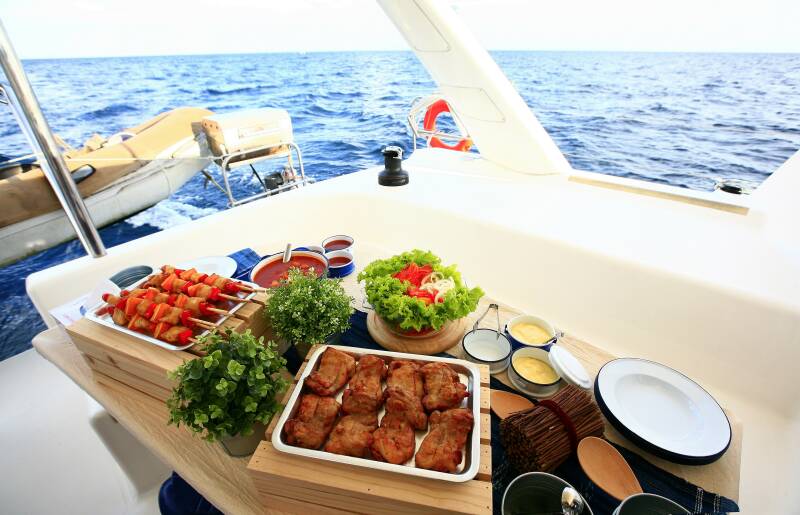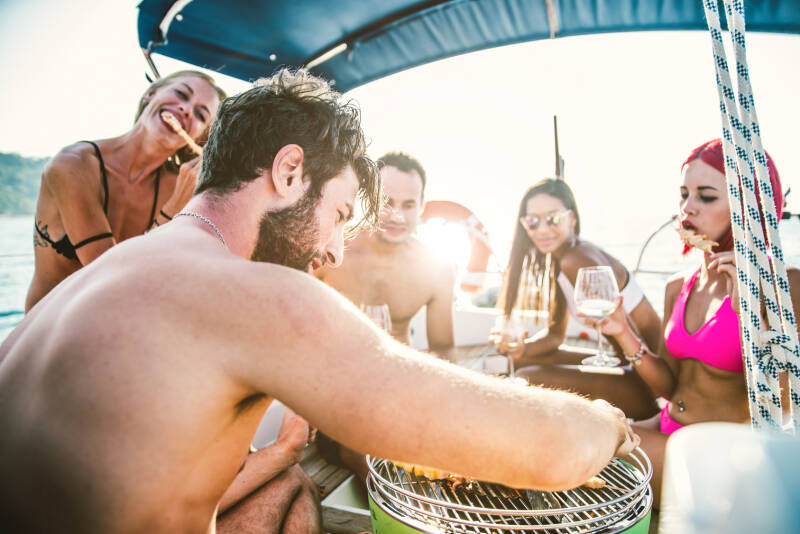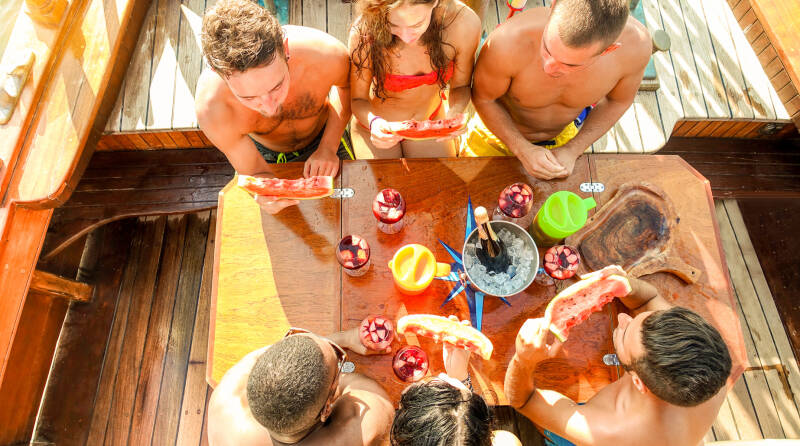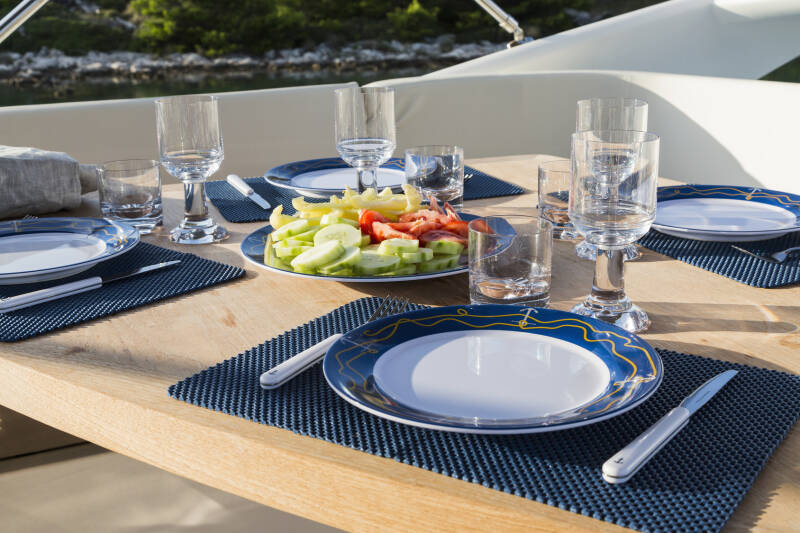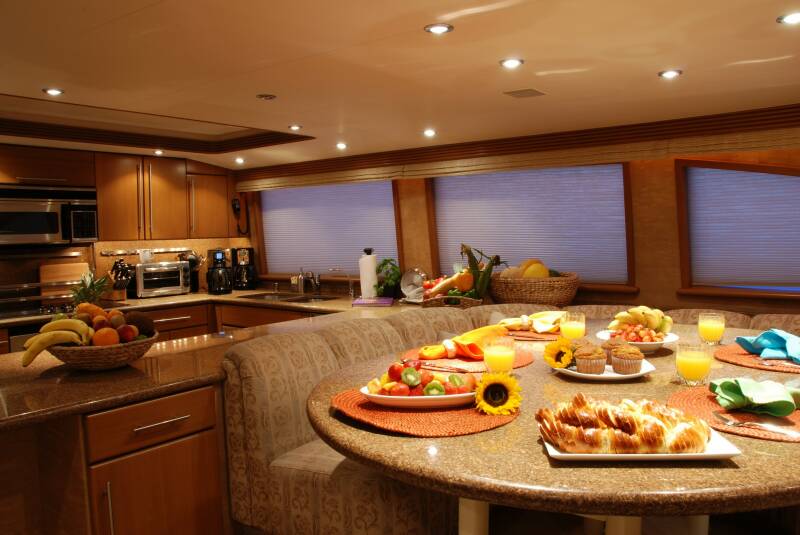Tips for Successful Cooking on Board
To be able to cook successfully in a boat kitchen, follow these sailing cooking tips we offer, and you will be fine. To use the space wisely, bring only the minimum of cooking equipment (often the boats are already equipped with the most necessary utensils), attach pockets to the wall for storing silverware, spices and tools, such as the bottle or can openers. Since preparation areas are usually minimal, avoid bringing food that involves a lot of chopping.
Put away any dangerous utensils if you are not using them because a boat moves even when docked, and any sharp objects can fall or hurtle across the boat, hurting someone. Use non-slip mats or damp tea-towels to stop plates or cutting boards sliding. Use lump sugar - it is far less messy than granulated which can spill all over. It is good to have at least one pan with a locking lid for cooking one-pot meals in rough weather. Pressure cookers on a yacht are also an excellent investment for preparing aboard a yacht since they reduce cooking time considerably. Make sure that everyone in the crew knows how to light the stove and control the fuel supply safely. If it is a gas installation, keep the gas bottle turned off when you are not using the oven.
What Food to Buy for a Sailing Trip and in What Amount
The amount of food you are going to take to your boat depends upon the number of people and rough estimates of how much each person can eat in a day, times the number of days of your sailing trip. The rule of thumb for cooking in small boat kitchen is to take a little bit extra.
That refers to the non-perishable food. Buy perishables in quantities that you can use before they go bad since you can get them every other day or whenever you are in port. There are no restrictions on which food you may take on board. Do not forget to get snacks and enough drinking water. This also includes alcohol and non-alcoholic drinks.
Cover Daily Meals
So, what food to buy for your first sailing experience with boat kitchen? It is a good idea to make a list according to meals - breakfast, lunch, dinner. For breakfast, you would typically buy milk, cereals, bagels, eggs, ham, jams, butter and bread. For lunch, you can have anything you want. But if you are going to keep it simple, buy foods that can be assembled into light salads or sandwiches.
That includes lettuce, different vegetables, canned tuna, pasta, cheese and some meat, like chicken for example. Dinners usually require a bit more planning when cooking on a boat. You need to comply with everyone's tastes and habits - whether they are vegetarian or not - and, you should keep in mind the amount of groceries you are going to buy. They need to last, especially if you are not going to be able to go grocery shopping during your sailing holidays, and they also need to have a short preparation period. The last thing you want on your sailing holiday is to spend hours cooking in the boat kitchen. We suggest you buy tomato sauce, minced meat, steaks, vegetables, pasta, rice and beans. Snacks are also essential to have on your sailing food list, especially if you are taking children with you. Potato chips, granola bars, cookies, chocolate and dried fruit all fall into that category.
Get Enough Drinks
Remember that most usually the water on board is not for drinking and you should spend it wisely. However, when it comes to drinks, the rule of thumb is 1.5 liters/person/day to be found in the boat kitchen. Also, do not forget to buy enough soda and alcoholic beverages. You will most definitely end up drinking more of both than you do at home. Coffee and tea should also be on the list.
Buy Your Preferred Condiments & Spices
The only spices you might find in a yacht kitchen are salt and pepper (do not forget to check with your charter). Other spices and sauces like mayonnaise, ketchup, chili, etc. should be bought. If you travel along the Mediterranean coastline, you can find spices like rosemary, thyme, sage, etc. Use them, they are the best you can find.
The Difference Between a Kitchen on a Boat and a Regular Kitchen
The boat kitchen is not much different from your regular kitchen. The most significant difference is the size. In a galley kitchen, space is limited, as are fuel and refrigeration, so you need to plan and organize.
Size and Stability
In a boat kitchen, two burners on the pivoting stove or a microwave are considered luxury items. The sink is smaller than the one you have at home, so often large pots and pans will act as washbasins. Besides the minimal space for both keeping and preparing ingredients, in a yacht kitchen you will have to deal with limited utensils. Cooking must be done on water, while the kitchen together with the boat is heeling over, so you have to be steady on your feet. Most yachts have a gimbaled stove that stays horizontal as the boat rocks back and forth.





